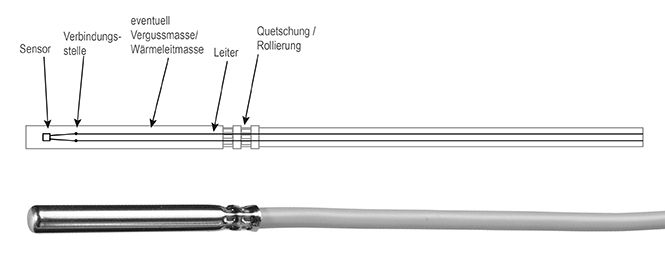Cable probe or resistance thermometer?

To measure the temperature in an application, there is more than one way. The simplest option is certainly the cable sensor. But the higher the demands on the sensor, the faster the simple cable sensor reaches its limits. Application temperature, installation situation, flexibility and reproducibility are only some of the influencing factors. In the following, the cable sensor and the sheath resistance thermometer (also called resistance thermometer or sheath sensor) are compared and the respective areas of application are shown.
The classic cable sensor
Simply constructed cable temperature sensors without the insertion of potting and heat conducting compounds as well as certain insulation elements are quite simple in their manufacture. They consist of a cable, to the end of which a sensor element (e.g. platinum sensor) is connected. The entire measuring insert (this is the name given to the sensor including insulation and possibly shrink tubing installed on the cable) is inserted into a protective sleeve, which protects it from environmental influences. With the help of the potting compounds already mentioned, a high IP protection class (up to IP68) can also be achieved for these sensors. The use of thermal compound also ensures that fast response times are achieved. A secure connection between the sleeve and the cable is ensured by means of crimping or rolling. Depending on the raw material prices and the design of the measuring insert, the classic cable sensor can be a very cost-effective way of measuring temperatures. Few components and work steps also ensure a low price in production.
However, depending on the requirements, this simple design of a temperature measurement also reaches its limits. Although the cable sensors can be potted waterproof up to maximum continuous temperatures of approx. 3 50 °C, there is still the possibility of water vapor getting inside the sensor. Particularly when glass-silk cables are used at high ambient temperatures (>260 °C), moisture can penetrate to the measuring insert and impair the function. Reproducibility is also only possible to a limited extent. The location of the sensor varies minimally from sensor to sensor which can lead to small deviations of the measured values. Last but not least, the installation situation often requires a design adaptation of the temperature sensor. The protective sleeve of cable probes is rigid and therefore offers only few possibilities for flexibility. Particularly in the case of sensors with a thread, so-called screw-in sensors, more space is required, which may not be available depending on the installation space.
The sheath resistance thermometer
Similar to the structure of a sheath thermocouple, the sheath resistance thermometer consists of two conductors, but made of copper rather than thermocouple material. These are enclosed by magnesium oxide and a stainless steel sheath (e.g. Inconel 600). In the measurement industry, this is referred to as sheathed measuring cable. This is shortened to the required length and the sensor element (e.g. Pt1000) is welded to the exposed copper wires. This process makes it possible to always place the sensor elements in the correct position, even if two sensor elements are installed in one sensor, which must be at the same height and in the same radial position. Another stainless steel sleeve encloses the sensor elements and is welded to the end of the sheath measuring line. Now the sensor elements are embedded in tightly compressed magnesium oxide. Finally, the sensor is sealed by means of a pastille. The magnesium oxide ensures that the sensors are encapsulated in a vapor-tight manner and, due to their structure, can withstand high pressures and temperatures of up to 600 °C without any problems. Thanks to their robust design, the probes are vibration-resistant and durable. Another great benefit: The sheathed measuring cable can be bent and thus individually adapted to the application and design.
All these advantages and properties mean that significantly more and higher quality basic materials are required for a sheathed resistance thermometer. The manufacturing processes are also more complex, which results in the higher price compared to a simple cable sensor. However, there is almost no difference in price compared to a cable sensor with a high-quality design (with R-glass cable).
The selection of the suitable sensor is therefore dependent on various factors in the application and the demands on the sensor or the accuracy of the measured value. We will be pleased to assist you with advice and the design of the suitable sensor.
For more information, please visit: https://www.bb-sensors.com/
News Categories
- » NEWS HOME
- » Automation & Robotics
- » Industry 4.0
- » Material Handling
- » Sensors
- » Quality & Testing
- » Machine Vision
- » Laser & Optics
- » Metalworking
- » Motion Control & Drives
- » Hydraulics & Pneumatics
- » Process Industry
- » Renewable Energy
- » Agriculture
- » Home & Office Furniture
- » Environmental Tech

